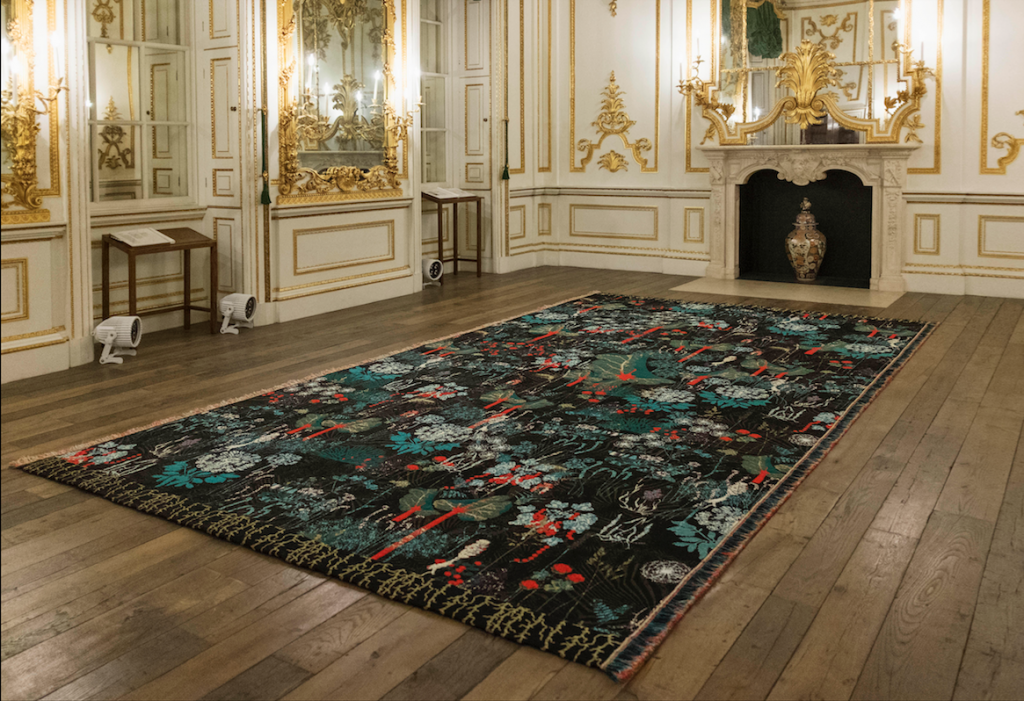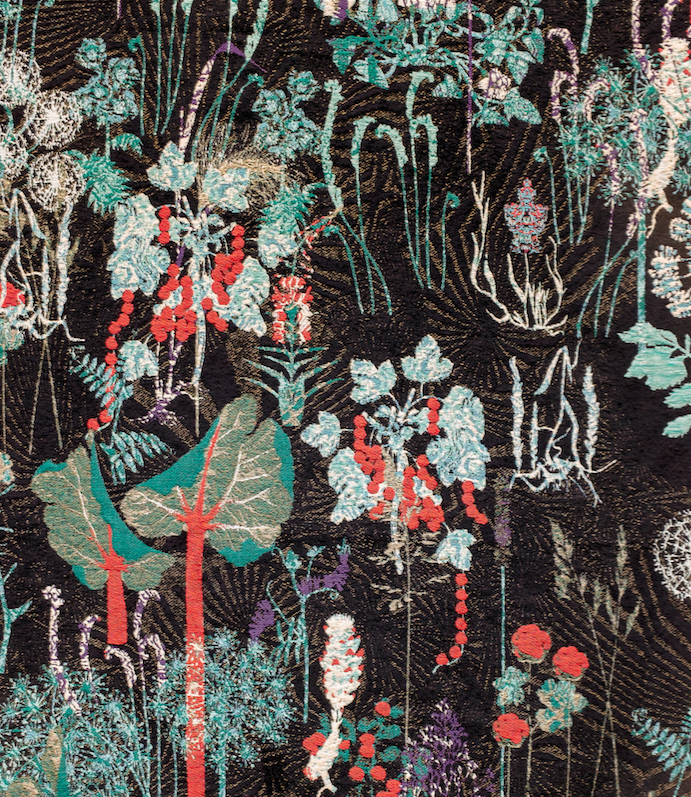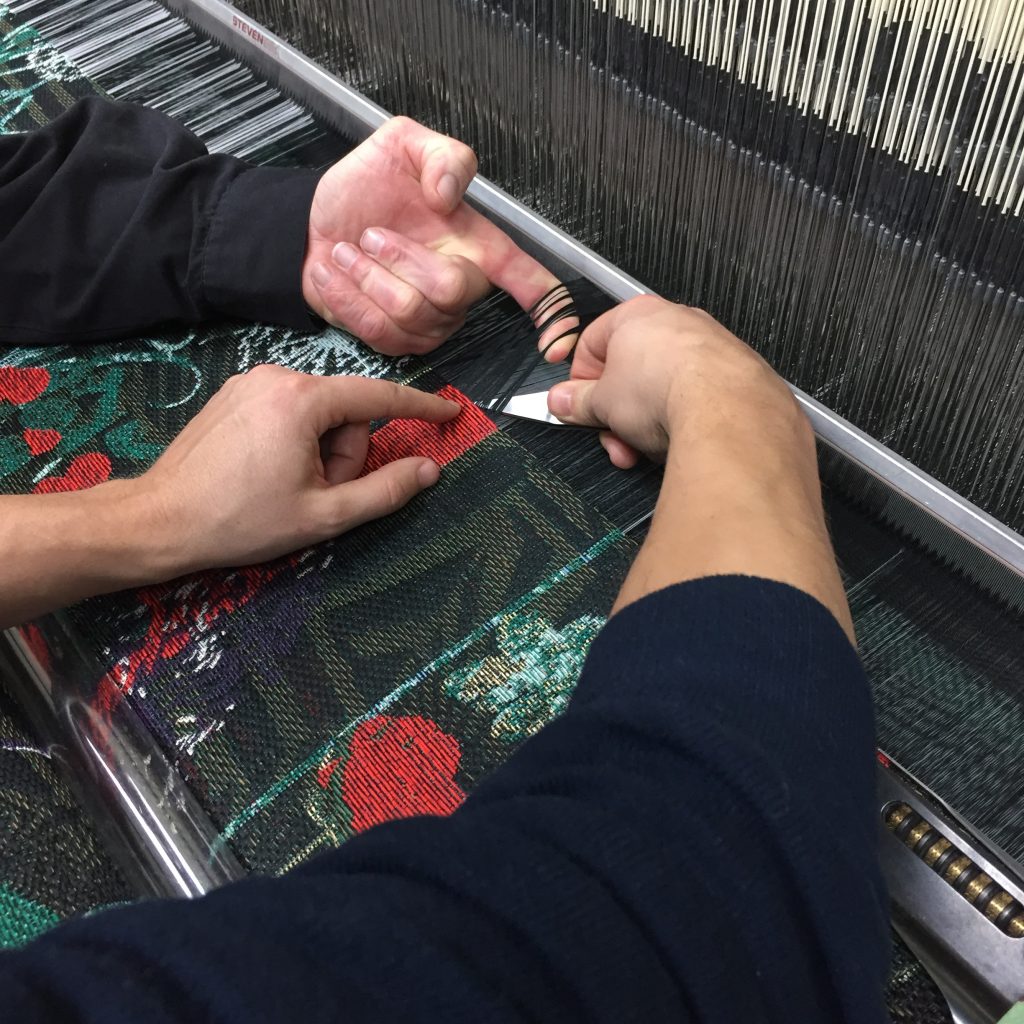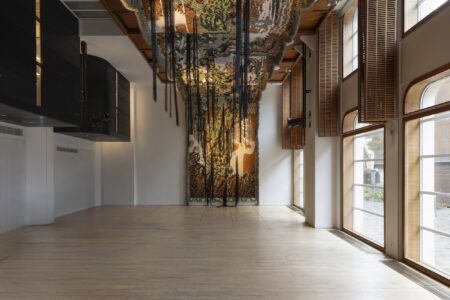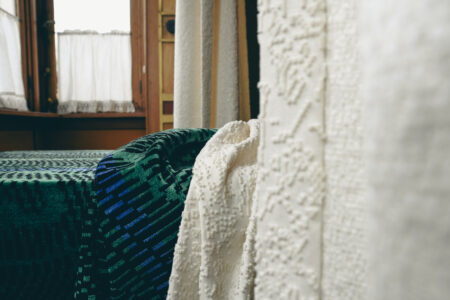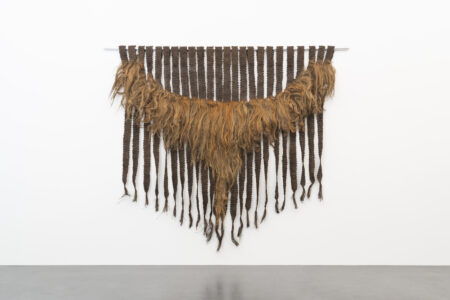
Woven Visions of a Distant Future
Patrik Söderlund from IC-98 discusses the many narratives woven into the future-gazing tapestry, ‘A World in Waiting’, produced in collaboration with Kustaa Saksi
In 2017, the artist duo IC-98, comprising of Visa Suonpää and Patrik Söderlund, teamed up with artist and designer Kustaa Saksi to create a vision of the world in 2,000 years time. The result was an intricately woven tapestry of wildflowers that grapples with ideas of a positive apocalypse. The piece is called A World in Waiting. It is currently on display at the RIGA Biennale and the Kunsthalle, Helsinki.
We spoke with Patrik Söderlund about the many layers and narratives woven into the tapestry and the process of collaboration.
TLmag: Tell us about the thinking behind ‘A World in Waiting’.
Patrik Söderlund:
It’s quite a long story… but I’ll try to be concise.
Basically, we did it because we were invited to contribute to the project Collecting Europe for the Victoria and Albert Museum (V&A) and the Goethe-Institut in 2017. The idea of the project was to imagine Europe in 2,000 years time. We were asked because we had been thinking quite a lot about the future, and deep-time, and long-time directions.
So, we did a research trip to the V&A. We went to see the big tapestries, the hunting tapestries. We have always been drawn towards tapestries because of how they portray the world–there is the realism and then, at the same time, the stylized quality. It corresponds with our animations, in which we superimpose fantastical occurrences and realistic elements together. Another important reference point were the unicorn tapestries at the Cloisters Museum in New York which is part of the Medieval Met collections. I kept thinking about at the plants in both the unicorn and hunting tapestries and then the ideas came about quite naturally.
How did the site of the V&A influence your work?
In these kinds of projects, we tend to work site specifically, to add something to the context. In this case, we thought that it would be great to continue the tradition of the V&A as an institution and be in dialogue with the collection. So tapestry and its history of applied arts was a good starting point.
What other things shaped your concept for the work?
We were thinking from a post-humanistic perspective. Trying to omit all the humans and the animals and just give center-stage to the millefleurs [thousand flowers] and make it a meadow.
On another level, of course, there needed to be the element of future. I’d been reading about the Svalbard Global Seed Vault and we were thinking about a setting for our vision of the meadow without humans. We were also thinking about climate change and the Arctic Ocean–it’s one of the fastest warming areas in the world at the moment. So we combined these elements.
Then, there were the ideas that culture and nature are completely intertwined and even if humans disappear, nature will still be shaped by man, by humans, for millennia to come. In a way, the Svalbard Seed Vault is a strong symbol of that. But what happens when those seeds start to have their own lives? Which kind of flora would be dominant from Svalbard in 2,000 years?
I have read that you wove the seeds depicted in the tapestry into it, could you tell us about this?
That’s a good point. It’s always difficult to talk about some of our work because there are so many levels that I forget some! From the very start, we realised that we should weave seeds into the carpet. Not only would we make a picture of the world but also give it a materiality. That’s actually why it’s called A World In Waiting. It depicts a world that is waiting and, because we have those seeds there, it is also a world waiting to be born. Waiting to sprout. It is pregnant in a way, the carpet, it’s waiting for its time.
The idea for the seeds was inspired by one of our first trips to the V&A. We went to the tapestry galleries and we noticed that one tapestry was missing. We saw plastic buckets on the floor and, obviously, this raised some suspicions. We talked with the people there who confirmed what we were thinking– water had leaked through the roof and one tapestry was totally soaked so they had taken it to the conservation department.
It was quite interesting, how the outside world creeps into man-made structures. So we thought when our carpet inevitably rots it can become the growing ground for the plants it depicts through the seeds. The man-made would be destroyed or wither away but there would still be life.
Coincidentally, after we had made the tapestry, there was the news that water had leaked into the seed vault in Svalbard which was supposedly made to stand the test of time. The future that we envisioned to happen in 2,000 years, was already happening.
Was that difficult to achieve technically?
Yes and no.
First of all, there was the sourcing of the seeds. Some seeds were quite easy to source and others were more difficult. We were working with the Natural Resources Institute Finland to do this. Some seeds we couldn’t get because of the seasons. This is one element that I like–we do conceptual work like this, thinking theoretically and philosophically but then we are faced with seasonality. It made us realise that conceptually speaking, the work could be better if we could include more seeds. But at the same time, we simply could not include them, which is a great thing.
Technically speaking, we wanted to weave the seeds into the tapestry and not just attach them on the backside or something like that. We worked with Tilburg’s TextielLab to figure out how to achieve this. They can do every imaginable thing with textiles, so it was no problem for them. The engineers designed a kind of double-sided structure for the weave so that there would be natural pockets in it for the seeds which were placed in tiny cotton pouches.
Once that was figured out, it was relatively easy. We started the weaving machine and then we watched it, looking for spots to insert the pouches. When we found one, we’d stop the machine and then put the seeds there and, once the machine started again, the weave encapsulated the seed. It was a bit time-consuming, as we had to keep stopping the machine but otherwise, it was quite okay.
How did the collaboration with Kustaa Saksi come about?
We had seen Kustaa’s works a few years back, in Madrid, when we both had exhibitions on at different venues at the same time. We didn’t know Kustaa but we knew his work and really liked it. We thought that this brief would be a great moment to invite an artist who is also a designer to work with us as it would close the project in a perfect circle.
How did the collaboration work? Did you have specific roles? What was the process like?
From IC-98’s point-of-view, it was a slightly new situation. It’s always risky when you invite somebody to do a work with you. Although we had never met Kustaa, we clicked immediately and it was a super enjoyable collaboration.
Normally, with IC-98, Visa does the drawings and final visualisations, but this time he wasn’t doing that, so it was a new dynamic. Visa and I concentrated on the conceptual and research side. We were in dialogue with climate scientists and the people responsible for the seed program to define the plants that would be viable in 2,000 years time. We came up with the final selection of the plants. And we decided on the medium of the weave. Then, with this background research, we gave that material to Kustaa and he was completely free to interpret that research in the way he felt best and appropriate.
This is a simplification of course, because we were talking before starting and along the way but for us, it is important that when we invite somebody like Kustaa, there should be a real collaboration going on. Although the idea basically comes from us, he needs to have full creative control of the part he is doing.
The tapestry is now showing in exhibitions in Finland and Latvia, why these places?
What happened was, I had a meeting withKaterina Gregos, the curator of the RIGA Biennale. She wanted to include the tapestry in the show. And we said okay, obviously, of course, because the concept for the Biennale was super great [this year’s theme is ‘Everything Was Forever Until It Was No More’].
But, at approximately the same time, we were invited by the Kunsthalle, Helsinki, to do a solo show on quite short notice. It is an overview of the last three years of our practice so it would have been unthinkable not to include the carpet. We realised that two places needed to have the same work at the same time… We just had to do it, so we had a copy of the carpet made.
How do think the piece changes as it moves? Does it have a different message away from the V&A?
Here, maybe, the dictates of the art world come into view… and I have mixed feelings about this. Obviously, we made the tapestry with the V&A in mind. For example, if you look at the gold in the tapestry, there wouldn’t necessarily have been gold in the design were it not for the gold on the walls where it was installed.
But, we know that this is a great and strong work and, because of this, it works in other places. There are enough levels to it that even if you take away the V&A layer, it still resonates.
Contextually speaking, the V&A is the defining place, in RIGA it’s included in a typical biennale way and with the solo show, the main context is our body of work so it became part of that narrative.
Could you expand on how it fits into the solo exhibition and your other works?
Before the tapestry, we had been doing quite a lot of dark work. People see our two latest animations, Nekropolis and Epokhe as melancholic and dark, and they are. So we asked ourselves, would it be possible to talk about the same things in positive terms? I don’t mean positive from the human perspective but positive from the point-of-view of other species. So what good could we see in this apocalyptic moment of climate change? That’s actually really important. It’s what made us interested in using plants and flowers in the first place.
In the solo show, the tapestry plays an important role because of how it is installed–you can start the show with it and see that there is life and then comes the Nekropolis and the dead and all that follows. But then, actually, it’s the last piece of the show also, which shows that when everything is lost from the human perspective, we still have a huge future. So I see it as a very optimistic and beautiful work although it is totally part of the apocalyptic tradition.
Is this tension between utopia and dystopia a theme you’d like to keep working with in the future?
I think yes. We are going to collaborate with Kustaa on a smaller scale piece later this year. The concept is ready and, again, there is the element of stitching or weaving. It also includes plants, but it’s a little bit different. It’s a sort of companion piece to the big tapestry.
We’ve done these companion pieces before, where you have a couple of works that create a constellation. They tell the same story from different perspectives, from different points-of-view. So I would say this new one, it adds another perspective to A World In Waiting. And I’m not saying anything else about that for now…
A World in Waiting will be on display at RIGA until October 28 and at the Kunsthalle, in the exhibition ‘IC-98 2016–2018’ until August 5
